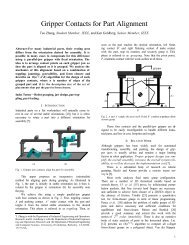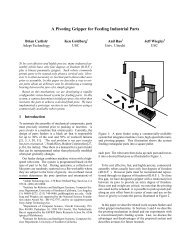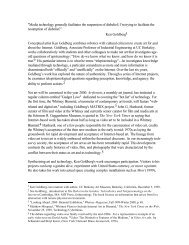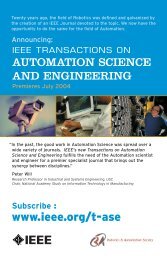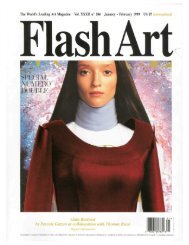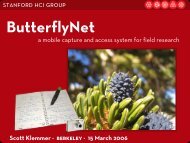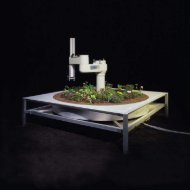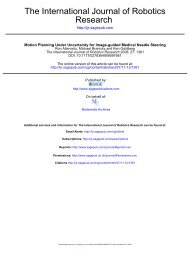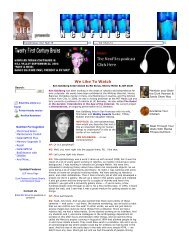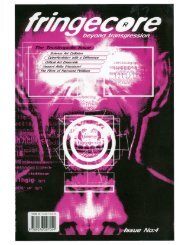“Are We There Yet?” Visual Tracking of Visitors ... - Ken Goldberg
“Are We There Yet?” Visual Tracking of Visitors ... - Ken Goldberg
“Are We There Yet?” Visual Tracking of Visitors ... - Ken Goldberg
You also want an ePaper? Increase the reach of your titles
YUMPU automatically turns print PDFs into web optimized ePapers that Google loves.
<strong>“Are</strong> <strong>We</strong> <strong>There</strong> <strong>Yet</strong>?<strong>”</strong> 7<br />
<strong>of</strong> the background image with probability distributions, and use these models<br />
to classify pixels as foreground or background. Many <strong>of</strong> these algorithms are<br />
parametric [9], [14], leading to efficient storage and computation. In outdoor<br />
scenes, mixture-<strong>of</strong>-gaussian models capture complexity in the underlying distribution<br />
that single Gaussian distribution models miss [17], [31], [34], [41]. Ours<br />
is nonparametric: it estimates the distribution itself rather than its parameters.<br />
For nonparametric approaches, kernel density estimators are typically used, as<br />
distributions on color-space are very high-dimensional constructs [11]. To efficiently<br />
store distributions for every pixel, we make a sparsity assumption on the<br />
distribution similar to [23], i.e. the random variables are assumed to be restricted<br />
to a small subset <strong>of</strong> the sample space.<br />
Other algorithms use foreground object appearance models, leaving the background<br />
un-modeled. These approaches use support-vector-machines, AdaBoost<br />
[12], or other machine learning approaches in conjunction with a training dataset<br />
to develop classifiers that are used to detect objects <strong>of</strong> interest in images or<br />
videos. For tracking problems, pedestrian detection may take place in each frame<br />
independently [1], [37]. In [29], these detections are fed into a particle-filter multitarget<br />
tracking algorithm. These single-frame detection approaches have been<br />
extended to detecting patterns <strong>of</strong> motion, and Viola et al. [38] show that incorporation<br />
<strong>of</strong> dynamical information into the segmentation algorithm improves<br />
performance. Our algorithm is based on different operating assumptions, notably<br />
requiring very little training data; initialization uses only a couple seconds<br />
<strong>of</strong> video.<br />
A third, relatively new approach, is Robust-PCA [7], which neither models<br />
the foreground nor the background, but assumes that the video sequence I may<br />
be decomposed as I = L + S, where L is low-rank and S is sparse. The relatively<br />
constant background image generates a “low-rank<strong>”</strong> video sequence, and<br />
foreground objects passing through the image plane introduce sparse errors into<br />
the low-rank video sequence. Candès et al. [7] demonstrate the efficacy <strong>of</strong> this<br />
approach for pedestrian segmentation, although the algorithm requires the entire<br />
video sequence to generate the segmentation, so it is not suitable for our<br />
real-time application.<br />
Generally, multi-target tracking approaches attempt to find the precise tracks<br />
that each object follows, to maintain identification <strong>of</strong> each object [4]. For our purposes,<br />
this is unnecessary, and we avoid computationally intensive approaches<br />
like particle-filters [28], [29], [39]. Our sub-optimal approximation <strong>of</strong> the true<br />
maximum likelihood multi-target tracking algorithm allows our system to avoid<br />
exponential complexity [4] and to run in real-time. Similar object-to-track matching<br />
utilizing the Gale-Shapley matching algorithm is explored in [2].<br />
Other authors have pursued applications <strong>of</strong> control algorithms to art [3], [15],<br />
[19], [20], [21], [32], and the emerging applications signal a growing maturity <strong>of</strong><br />
control technology in its ability to coexist with people.


